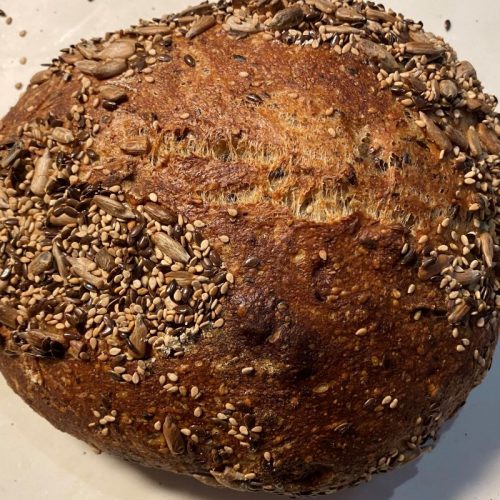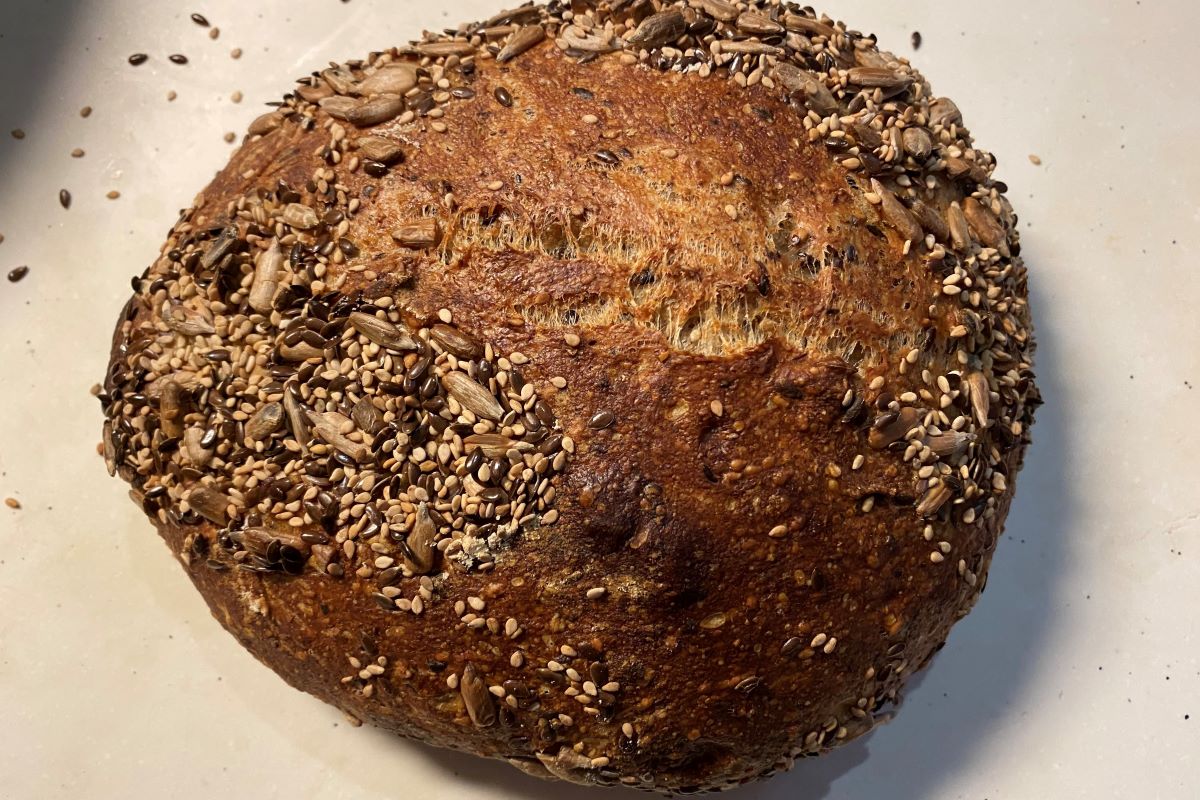This whole wheat rye sourdough bread with seeds is for lovers of a healthy and very tasty bread. Using a sourdough starter enables you to play around with the level of acidity developed in your bread. The final bread is lightly acidic, very airy and with a thick crust. After cooling, you can cut this bread and freeze the slices. They redevelop a wonderful taste after a minute in the toaster to refresh. This way you have every morning bakery fresh bread on the table! While the management of your barm takes regularly some attention, this bread is not difficult to make!
The art of making whole wheat rye sourdough bread with seeds
There are several important pointers to make this bread work out in its full glory!
The pre-work
First, this is a high hydration bread. So you use almost the same amount of water as the solid components in the bread! And therefore the usual kneading is fully replaced by folding! Also we use high gluten bread flour (hard winter wheat). We first make a starter from a barm. We ensure to let the remaining water and flour/seed/salt mix in the recipe to stand for at the least 30 min. This helps to absorb water and let the natural bacteria in the flour to start doing their (enzymatic) work. We do the main fermentation at room temperature to stimulate yeast growth thus creating an airy dough. When the dough has roughly doubled in size, however, we start shaping the dough. Then we do the proofing overnight in the refrigerator where the lactic bacteria catch up and create more flavor.
The baking
The baking of the dough takes place on a stone at high temperature in a pre-steamed oven. This helps the oven spring and crust formation. Alternatively you can bake the loaf in a pre-heated cast iron Dutch oven, which is placed in the oven. First with the lid on to create the moist environment. Later the lid goes off to develop the crust. See for more background cooking hints: bread, dough, batter and noodless . The seeds on the crust also contribute flavor and we use toasted seeds in the dough.
Special equipment
- oven
- banneton with cloth lining (can use a basket with tea towel)
- baking sheet
- baking stone (preferred)
- plastic foil

Whole wheat sourdough bread with seeds
Ingredients
Ingredients for the starter
- 5.4 oz (150 g) barm see Remark 1 as to how to make the barm
- 5.4 oz (150 g) unbleached, high gluten (strong) bread flour
- 5.4 oz (150 g) water remove chlorine from the water if it has
Ingredients for the bread
- 6.25 oz (175 g) unbleached, strong (high gluten) bread flour
- 4.3 oz (120 g) whole wheat flour
- 1.4 oz (40 g) whole rye flour
- 1 oz (30 g) sunflower seeds
- 1.25 oz (35 g) sesame seeds
- 1.25 oz (35 g) flax seeds
- 0.32 oz (9 g) salt
- 11.6 oz (326 g) water remove chlorine from the water if it has
- 1.5 oz mixed seeds (sunflower, sesame, flax seed) to cover the bread
Instructions
Instructions to make the starter
- Take the barm (which was refreshed 8-24 h before) from the refrigerator
- Mix bread flour, water and barm in a bowl with a fork to make a homogeneous mixture
- Let ferment at room temperature to at the least double the volume
Instructions to make the bread
- While the starter is in development, toast the seeds, separately in a flat iron pan. They should become fragrant, a bit colored but not black. The sesame and flax seeds will become springy in the pan and then it is time to stop heating
- After cooling, grind the flax seeds in a mortar and pestle to make the flax seed meal
- When the starter is about ready, mix the dry flours, the seeds, seed meal and the salt
- Add the water to the above mixture and thoroughly mix. make sure all flour gets wetted and let stand for 30-45 min at room temperature
- Then mix the starter with the wetted, autolysed flour/seed mixture using a spatula or a fork. Do this in a wide bowl. Mix well. There is no kneading in making this bread, other than mixing and folding
- During the next 1.5-4 h (depending mostly on your room temperature) let the mixture ferment on your counter at room temperature. Every 15-45 min (the 15 min in warmer kitchens and the 45 min in colder kitchens) make a full fold of the dough.
- A full fold is done by using wet fingers and taking the dough on one (far) side (of the bowl), stretching it upwards and folding it towards you to the opposite side. Do this first north to south, then south to north (by first turning the bowl 180 degrees), then east to west and then west to east. This is one full fold.
- When the dough has doubled in size, start shaping
- We can do the shaping on the counter, dusted with bread flour. Fold it in the shape of the banneton you want to use
- On the cloth lining of your banneton, spread some of the not toasted seeds
- Take with your floured hands the shaped dough and place it with the folds up in your banneton
- cover with a plastic bag or with plastic wrap and let it proof in the refrigerator for 6-15 h
- When the proofing is done, pre-heat the oven to 480 F (250 C). if you have use a baking stone
- After the proofing, place the dough on a baking tray covered with baking paper (I usually place baking paper on the bannetaon, then the baking tray upside down on that and then move banneton and and baking tray upside down. Then remove the banneton carefully, letting the cloth release the seed covered, proofed dough
- Score the dough 1/2 inch deep with a very sharp, oiled knife in a quick movement along the dough
- Reduce the oven temperature to 428 F (220 C), bring in some steam and immediately place the baking tray in the oven, on the hot stone if using. Bring in extra steam and do not use heat from above to let the oven spring do its work for 15 min. Thereafter bake with heat from above and from beneath for another 30-35 min. When you use the dough from the fridge directly into the oven, the oven spring may take a bit longer than when you use a proofed dough that was first adjusted to room temperature. If your oven has enough heating capacity, just bake the dough straight from the refrigerator, perhaps a few minutes longer
Notes
Food allergy & intolerance information: gluten
Remarks
- To make a barm from scratch, please check out sourdough barm for high hydration breads.
- If the very strong (high gluten) flour is not available, the bread will become flatter, but the taste is still superb. Additional gluten could also be added to the flour if the very strong flour is not available. The rise is both dependent on the protein content in the flour, as well as on the effort to let the gluten develop, which is the baker’s influence.
- An initial, high pre-heated oven temperature will help to create more oven spring as long as the dough surface is wet and flexible (steam will condense on the cold dough surface).



